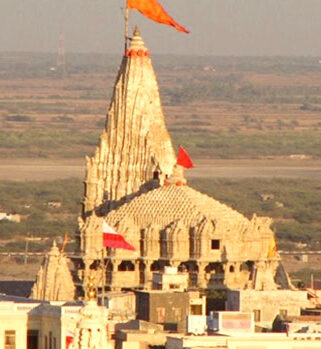
The Epitome Of Religious Values
The world famous ancient town of Dwarka hardly needs an introduction. Located on the confluence of Gomati River and the Gulf of Kutch, Dwarka is Lord Krishna’s town. The original temple of lord Krishna is believed to be constructed by Vajranabhji, the great grandson of Lord Krishna. The existing temple is a 15th / 16th century structure constructed in the Chalukya style in an area of 27 m x 21 m. Its tallest peak is 51.8 m high, its east-west length is 29 m and north-south width is 23m. It is said that a pilgrim to Dwarka starts receiving Punya of Ashwamedh Yajna from the moment he commences his journey towards Dwarka.
Mangal Darshan on Poornima at Dwarkadheesh’s Jagat Mandir
Dwarkadheesh’s Darshan on a full moon day (Poornima) is of great significance. In view of the rush of devotees on every Poornima, the Mangalaa Aarti is held at 06:00 am, and thereafter the Darshan remains open till 09:00 am. The decision of keeping the Mangala Aarti on Poornima early in the morning was taken by the priests and has provided great relief to the devotees.
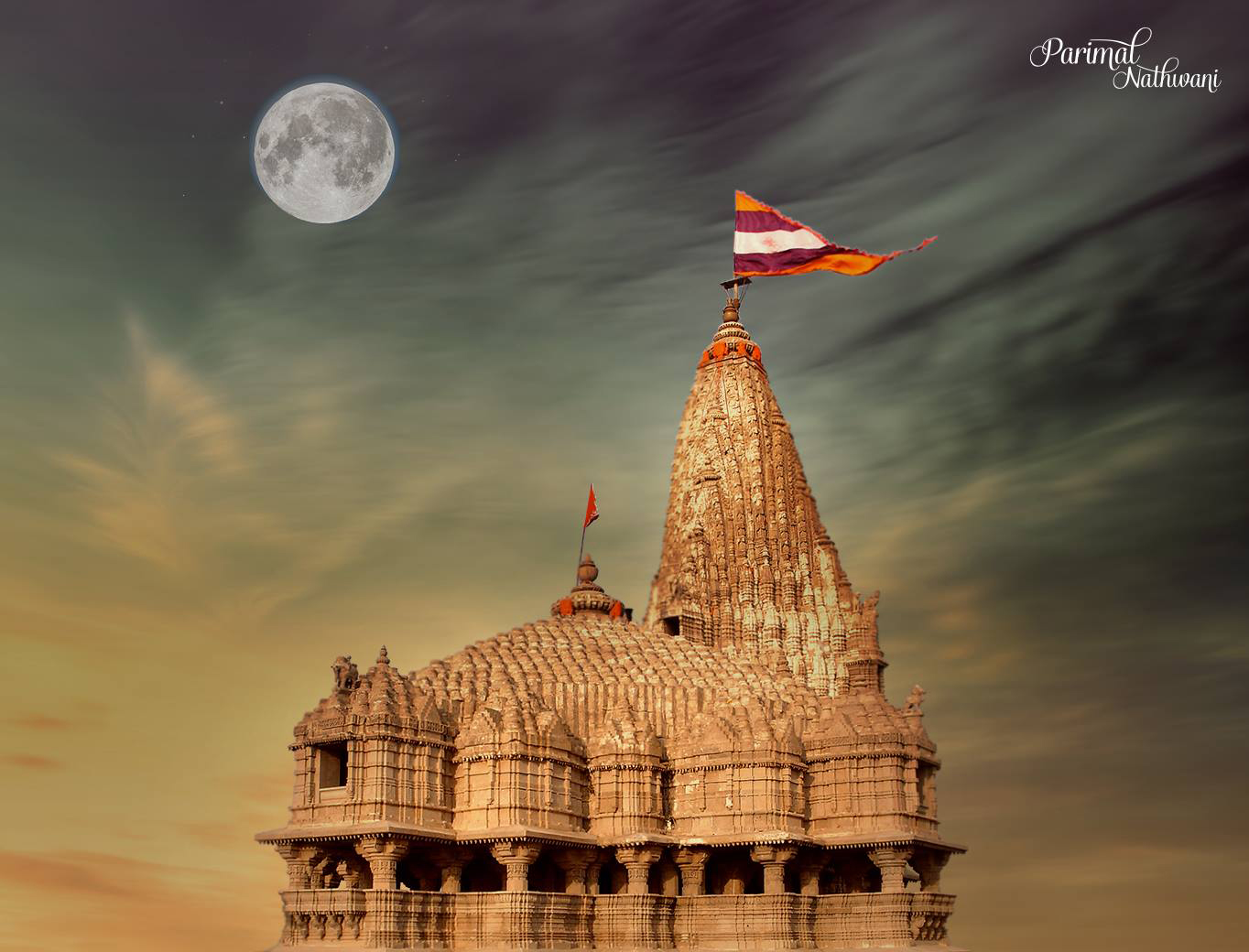
Temple Shikhars
Also known as Jagat Mandir or the temple of the world, the splendid Dwarkadheesh temple, in Dwarka is situated on the bank of river Gomati at a height of 40 feet. The height of the temple is 157 feet. It has two Shikhars:
Ladwa Shikhar, and Nij Shikhar
The Nij Mandir Shikhar has five stories, and it is in this Shikhar that the idol of Lord Dwarkadheesh is placed. The construction of the temple is based on 60 exquisitely carved pillars. The temple is spread 90 feet in the east-west direction and 70 feet in the north-south direction. There is no arch in the temple while the pillars are built from one stone. The effect of Greek civilization can be seen in the sculpture.
Various sculptures depict that the Guptas, the Pallavas, the Martraks, the Chavdas and the Chanakyas would have ruled here. According to a myth, Lord Vishwakarma built the temple in a single night. Interesting descriptions of its construction are found in Puranas.
It is believed that fearing attack from Jarasangh and Kalayan, the Yadavaas left Mathura and arrived at the coast of Saurashtra. They decided to build their capital in the coastal region and invoked Vishwakarma, the deity of construction. However, Vishwakarma said that the task could be completed only if Samudradev, the Lord of the sea, provided some land. Shri Krishna worshipped Samudradev, who was then pleased and gave them land measuring 12 yojans and then Lord Vishwakarma built Dwarka, a city of Gold.
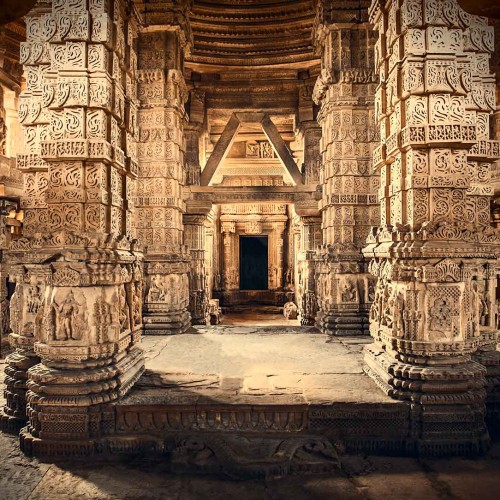
The Temple Entrance
The entrance of the Dwarkadheesh temple is to the north, from where the devotees enter the temple. God Dwarkadheesh is facing eastward. The entrance is known as ‘Moksha Dwaar’ on the other end i.e. to the south, is the ‘SwargDwaar’ from where one can reach the bank of river Gomati by stepping down 56 steps.
On the right hand of the Moksha Dwaar entrance is Shri Kusheshwar Mahadev, Satyanarayana temple and Navagraha temple. Moving ahead comes a huge temple of Lord Krishna’s family Goddess Ambaji.
After this temple comes the temple of Shri Purshottamraiji. During the Purushottam month, special celebrations and Pujan-Kirtan are done in the temple. Further ahead is the temple of Lord Dattatreya. Lord Dattatreya is the master of the masters and is considered one of the 24 incarnations of Lord Vishnu.
Surrounding Temples
On the backside of Shri Dwarkadhish Nij Mandir is the temple of Shri Durvasa Rishi. Durvasa Rishi was the family priest of Lord Krishna. To its back is the Patrani temple, surrounded by various other temples, including Shri Jambuvatiji, Shri Radhikaji with Lord Krishna, Shri Laxmi Narayan, Shri Gopal Krishna, Shri Laxmiji, Shri Satyabhamaji and Shri Saraswatiji temple.
Adjacent to the Patrani temple is the “Math” of Shri Shankracharyaji. From Trivikramji and Madhavraiji’s temples, one can reach the 56 steps entrance.
To the south of the Nij Mandir is the fascinating Shri Tri-Vikramraiji temple. The temple is peculiar because of its unique sculpture work. The sculpture seems to be from the Solanki era. On one side of the temple is the Garudaji – an eagle (a vehicle of the Lord Vishnu) and on the other side are the attractive idols of Shri Ganesh-Laxmi-Ridhdhi-Siddhi.
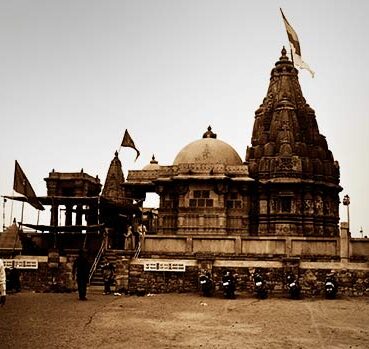
To the opposite of the Tri-Vikramraiji temple is the temple of Shri Madhavrayji. Its sanctum (Garbhgruh) is small but has a huge worship pandal or the darshan mandap.
There is a small but beautiful temple of Shri Radha-Krishna situated beside the temple of Shri Madhavrayji.
Exactly opposite Lord Dwarkadheesh Nij Mandir, the idol of Mother Devkiji is installed. Devotees enter the Sabha Mandap and Darshan Mandap of Lord Dwarkadheesh Nij Mandir after paying obeisance to ShriDevkiji. In the middle of the Sabha Mandap is a small temple of Balaramaji, which is at a lower level. In the temple is also the idol of Shri Mahaprabhuji.
The builders of this temple have depicted their knowledge proficiency and propriety by placing the idol of elder brother Balaramaji in the Sabha Mandap and the idol of Mother Devkiji in vision with that of Lord Dwarkadheesh temple.
The sanctum of Lord Dwarkadheesh temple is so magnificent that one would not feel like moving ahead. One can also enjoy the place’s natural beauty through the jharokhas of the temple on each floor.
The Nij Mandir is the main temple of Dwarkadheesh and is the ultimate aim of devotees visiting this eternal and sacred pilgrim place of Dwarka.
The appearance of Lord Dwarkadheesh itself is so fascinating, picturesque, sacred and eye-pleasing that while worshipping one not only feels content, but the charm and beauty of the Lord prompts the devotee to automatically sing in praise of the Dwarkadheesh.
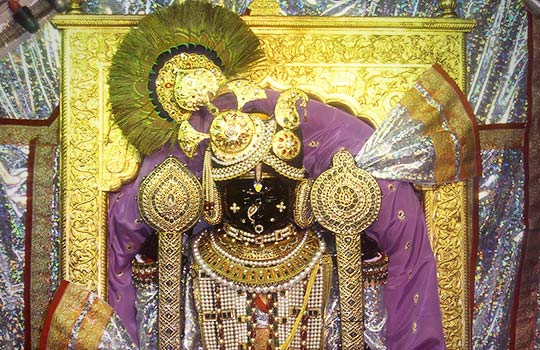
About The Idol
The idol of the Lord Dwarkadheesh made from black-stone is of 2.25 ft in height. Each of its four hands possesses conch (shankh), wheel (chakra), a metallic weapon (gada) and a lotus (padma). ‘Shankh, Chakra, Gada, Padma Chaturbhuj’ idol carries several interesting tales. The ancient idol was hidden to protect from attackers/invaders in a step-well viz. Savitri Vaav in Dwarka. The temple was sans the idol. Shrimad Vallabhacharya then brought another idol from Rukmini temple near Ladawa village and installed it in the temple. The idol remained there till 1551 A.D. Thereafter, the idol was taken to Bet in the 16th century during Turks’ attacks. The original idol was taken out from the step-well and reinstalled. Prior to that in the 12th century, it is believed that a royal warrior ‘Vijaysinh Bodano’ of Dakor took the idol to Dakor. The present idol is believed to have been installed by the Shankaracharya Anirudhacharya, who brought it from Dungarpur in Rajasthan.
The History
In the Jagat Mandir premises, a temple of Kusheshwar Mahadev near Moksha Dwaar has a significance of its own. Kusheshwar Mahadev is said to be an equal partner with Lord Krishna in Dwarka’s pilgrimage and not completing Darshan of Kusheshwar Mahadev is synonymous with an incomplete pilgrimage. The story of Kusheshwar Mahadev goes like this. There was a demon called Kush in the area long ago. The area was then called ‘Kushasthali’ – a place of Kush under his influence.
Everyone was scared of his devilish awe. People prayed to Lord Krishna to free them from the evil clutches of Kush. Krishna killed and crushed him till he went much below the ground beneath. Krishna then set up a temple of his family God Mahadev and hence the name Kusheshwar Mahadev was coined.
The speciality of the temple is that the Shivalingam is installed 20 ft. below the ground. Devotees offer prayers to Mahadev and then go for the Darshan of Krishna. As Lord Rama installed Rameshwaram Mahadev, Lord Krishna set up Kusheshwar Mahadev. Devotees offer a ghee lamp and laddus to accomplish their Dwarka pilgrimage.
The idol of goddess Shakti is on the fourth floor of Lord Dwarkadheesh’s temple. A sense of purity spreads amongst the tourist who visits this sacred and holy temple of Lord Dwarkadheesh.
The temple of Dwarkadheesh, also known as Jagat Mandir, is built on the north bank of Gomati Creek.
Architecturally, the temple is constructed on the same plan and system as most of the Hindu sacred edifices of antiquity.
In the precincts of a shrine there is a spacious assembly hall, the ceiling of which is supported in height about 170 feet. The temple has seven floors: There is a shrine of Shakti Mata on the fourth story while fifth reaching up to 100 feet has the Laadwa Mandir, the Length of the plinth of the temple is about 90 feet and its breadth is 20 feet. Externally the body of a temple and the spire are profusely curved from base to pinnacle, but internally they are characterized by excessive plainness and simplicity. The Shrine is elaborately ornamented and has a figure of Ganapati sculptured over the entrance.
